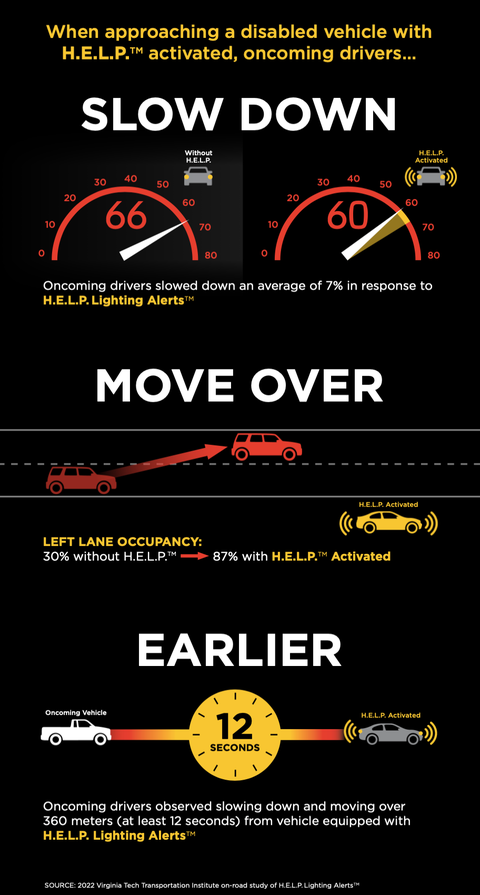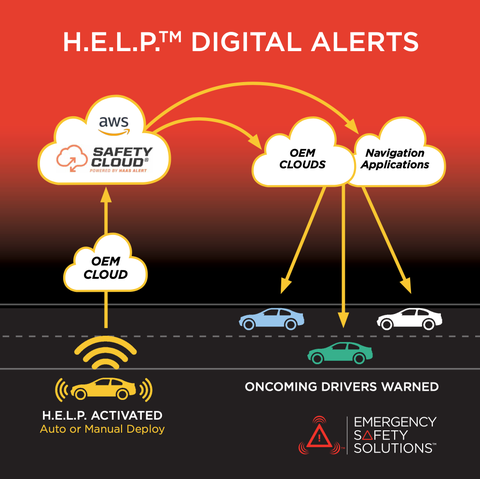- A study by Impact Research shows that on US roadways alone, collisions with disabled vehicles occur every seven minutes, impacting 72,000 people and causing 15,000 deaths and injuries every year.
- Getting noticed is a critical first step in staying safe when in a disabled car. That is one reason emergency vehicles have such conspicuous lights—to alert oncoming drivers to slow down and change lanes away from first-responder vehicles.
- Emergency Safety Solutions has developed a low-cost intelligent emergency communications solution with an enhanced hazard flash pattern designed to grab the attention of oncoming drivers.
Have you ever changed a tire beside a busy interstate, while other cars speed by at 70 mph, or stopped to help a fellow motorist with car troubles and feared you could be hit?
That nervousness is real, as disabled vehicles and their passengers are being struck by oncoming traffic at an alarming rate all across America. A study by Impact Research shows that on US roadways alone, collisions with disabled vehicles occur every seven minutes, impacting 72,000 people and causing 15,000 deaths and injuries every year. Equally disturbing, the frequency of these tragic events has been increasing the past several years.
The crashes happen because drivers typically don’t notice disabled vehicles with enough time to safely avoid them. While emergency vehicles are equipped with bright, highly noticeable flashers and digital mapping technology to help them be seen from great distances, most drivers have only their outdated hazard lights—which have not changed since 1951—to protect them and alert oncoming drivers.
Even the aviation and maritime industries embrace lighting and digital tools to avoid collisions and keep passengers safe. Yet drivers of the 280 million cars and trucks currently on US roadways must rely on a component that’s gone 70 years without a single upgrade to protect them when their vehicle becomes disabled.
Everyone is vulnerable
Getting noticed is a critical first step in staying safe when in a disabled car. That is one reason emergency vehicles have such conspicuous lights—to alert oncoming drivers to slow down and change lanes away from first-responder vehicles, as directed by Move Over laws now in effect in all 50 states.
The same logic should also apply to all vehicles. If oncoming drivers aren’t aware of a vehicle pulled over or stopped in the roadway, the risk of a collision is high. And, as the Impact Research study shows, disabled vehicle crashes are widespread and predominantly occurring on fast-moving freeways.
Take Chris Smith, for example. Smith, a current NFL player, experienced a tragic loss in 2019 while playing with the Cleveland Browns, when his girlfriend, Petara Cordero, was fatally struck by an oncoming vehicle, leaving behind their two-month-old daughter.
The two were traveling along an expressway in Ohio when Smith’s vehicle blew a tire and hit a guardrail. While the vehicle protected both occupants in the initial crash, Smith and Cordero activated their hazard lights, got out of the car, and were standing next to their SUV awaiting help when Cordero was struck and killed.
Unfortunately, this story is all too common, yet highly preventable.
HELP is on the way
Emergency Safety Solutions (ESS), a Houston-based startup, has developed a highly practical and low-cost intelligent emergency communications solution to help eliminate these tragedies.
ESS’ goal is to save lives by providing oncoming drivers far greater advance notice of disabled vehicles on the road ahead. ESS’ regulatory compliant Hazard Enhanced Location Protocol (HELP) safety communications feature provides multiple layers of protection for disabled vehicles and their occupants through three key actions:
- Digital Alerts: Notifications sent to oncoming drivers through in-vehicle dashboard displays and GPS mapping apps, such as Waze and Apple Maps, providing advance warning that they’re approaching a disabled vehicle, even beyond line of sight.
- Lighting Alerts: Dramatically improved, enhanced hazard flash pattern that is scientifically tuned and proven to grab the attention of oncoming drivers and prompt them to slow down and move over.
- Intelligent Controls: HELP deploys automatically when conditions indicate a safety need, such as a collision, tire blowout, driveline failure, or inattentive driver takeover (autonomous driving application) but can also be activated manually when the hazard signal is engaged and the vehicle is in park.
This spring, the Virginia Tech Transportation Institute conducted an on-road study to examine oncoming driver response to a disabled passenger vehicle with HELP Lighting Alerts flashing at 5 Hz (approximately 5 times per second) versus the standard hazard flash rate of 1.5 Hz. The study found drivers slowed down and moved over much sooner when approaching the vehicle with HELP’s higher frequency hazard lighting vs. traditional hazard lighting.
This simple and effective technology is a significant step in helping people stranded on the side of the road get noticed much earlier by oncoming drivers.
Today’s vehicles are more intelligent than ever and perform extraordinarily well in protecting passengers while the vehicle is moving. Yet at the same time, it’s amazing—and unacceptable—that the only method to protect passengers of disabled vehicles relies on last-century equipment that can’t communicate with other vehicles.
Other industries are far ahead of the auto industry in using digital and advanced lighting technology to make transportation safer for passengers, with ships, planes, and even golf carts able to show their position in real-time.
We need to do better.
Mike O’Brien retired in 2020 after 30 years in the automotive industry, with his most recent role as vice president for product, corporate, and digital planning at Hyundai Motor America. He is now executive director of business development for Emergency Safety Solutions, a Houston-based organization working to eliminate disabled vehicle crashes.
Have you had a frightening moment when stranded along the roadside? Please share your story below.














